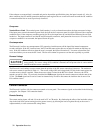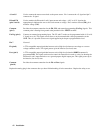
38 Installation
Connect The Power Cord
Your Agilent Electronic Load was shipped with a power cord for the type of outlet used at your location. Connect the
power cord to the ac input socket.
SHOCK HAZARD The power cord provides a chassis ground through a third conductor. Be certain
that your power outlet is of the three-conductor type with the correct pin connected to earth ground
(see Figure 3-1).
Turn-On/Selftest
Turn on the Electronic Load using the LINE switch on the front panel and observe the display. Immediately after turn-on,
the Electronic Load undergoes a selftest that checks the GPIB interface circuitry as well as the input circuitry of the unit.
All of the front panel LCD segments are momentarily activated. When selftest completes, the display should appear about
the same as the one shown in Figure 3-5 with the CC annunciator being on.
Figure 3-5. Front Panel Display
After the Electronic Load has passed selftest, connect a power supply to the Electronic Load to test the input circuits as
described under "Power Test".
If the unit fails any portion of the selftest, one of the following error numbers may briefly appear on the display:
GPIB Errors Input Errors
Display Description Display Description
ERROR 4 GPIB failure ERROR 100 Self test error
ERROR 5 Internal trigger failed ERROR 101 Secondary RAM failure
ERROR 102 Secondary ROM failure, power board
disconnected or thermistor open
ERROR 103 Secondary timer trigger failed
ERROR 104* Calibration EEprom failed
ERROR 105 Main DAC high
ERROR 106 Main DAC low
ERROR 107 Transient DAC high
ERROR 108 Transient DAC low
* Requires calibration.
Another indication that the Electronic Load has failed selftest is if the ERR annunciator on the display remains on after
selftest completes. If the Electronic Load has failed selftest, return the unit to the nearest Agilent Sales and Service Office
for repair.


















